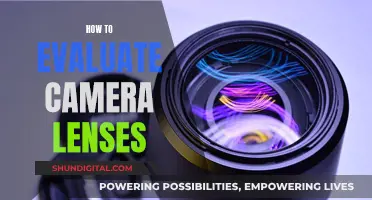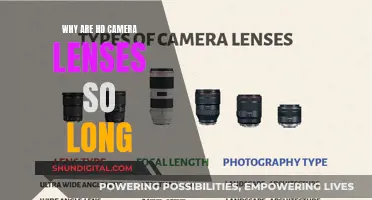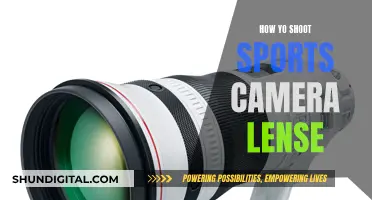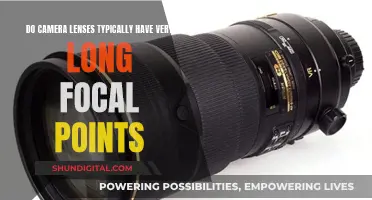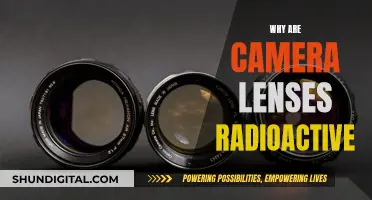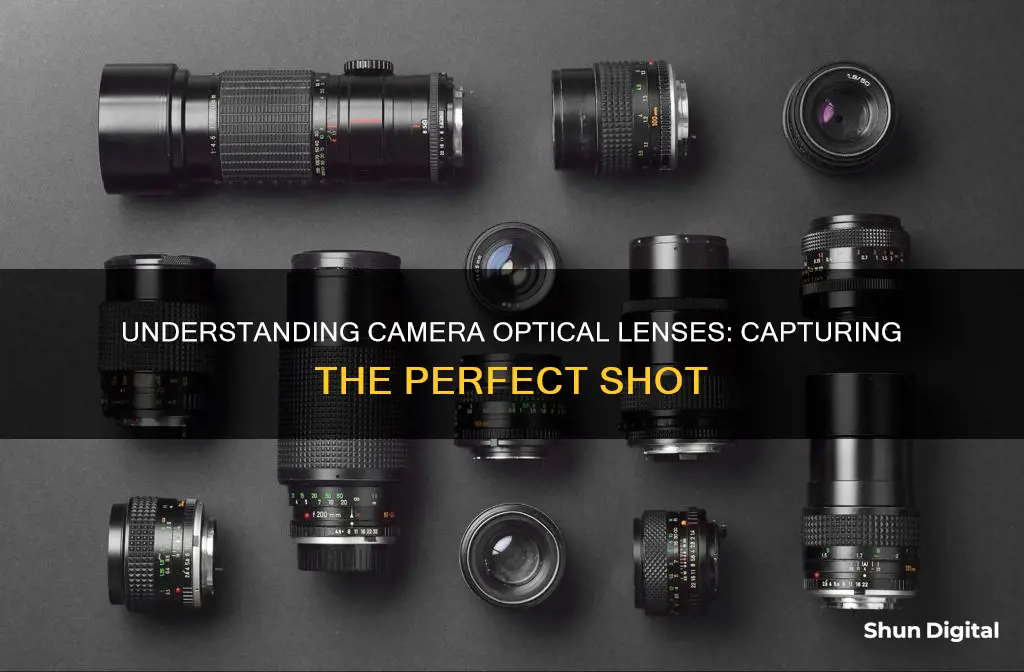
Camera lenses are an essential part of photography. They are the optical component of a camera, and their job is to focus light from what you see through the viewfinder into a tiny spot on the back of your film, DSLR, or mirrorless camera. Without a lens, a camera body cannot capture images.
A camera lens is made up of a single lens or an assembly of lenses that mount to a camera body. Some lenses are interchangeable, while others are built into the construction of the camera itself. Lenses can be made from glass, quartz glass, fluorite, plastics like acrylic, and even germanium and meteoritic glass.
Lenses have a number of characteristics that impact the final image, including aperture, focal length, and depth of field. Aperture controls how much light enters the lens, focal length dictates the field of view, and depth of field refers to how much space in front of the camera is in focus.
The focal length of a lens is particularly important as it determines the field of view and the magnification of the image. Lenses with a shorter focal length are known as wide-angle lenses and have a wide field of view, while lenses with a longer focal length are known as telephoto lenses and have a narrower field of view.
In summary, camera optical lenses are crucial in photography as they focus light and capture images by controlling aspects such as framing, perspective, depth of field, and the amount of light entering the camera.
| Characteristics | Values |
|---|---|
| Purpose | Focuses light from what you see through the viewfinder into a tiny spot on the back of your film, DSLR, or mirrorless camera |
| Function | Focuses and directs light onto the camera's image sensor or film |
| Control | Controls aspects like framing, perspective, depth of field, and the light entering it |
| Influence | Influences factors like sharpness, distortion, and other artistic choices for shooting a scene |
| Aperture | Controls how much light enters the lens |
| Focal length | Dictates the field of view |
| Depth of field | Refers to how much of your image is in focus (deep or shallow) |
What You'll Learn
- Camera lenses focus light onto the camera's image sensor or film.
- They control the aperture, which determines how much light enters the lens
- They control the focal length, which dictates the field of view
- They control the depth of field, which is how much space in front of the camera is in focus
- They can be used to manipulate and control the artistic and visual aspects of photographs

Camera lenses focus light onto the camera's image sensor or film.
Camera lenses are an essential component of photography, focusing and directing light onto the camera's image sensor or film. They are responsible for capturing images by controlling aspects such as framing, perspective, depth of field, and the amount of light entering the camera.
The lens plays a crucial role in influencing artistic choices, allowing photographers to manipulate factors like sharpness, distortion, and other visual aspects of their photographs. The quality of the lens directly impacts the detail and resolution of the captured image.
Lenses are typically made up of multiple lens elements that work together to refract and focus light onto the camera sensor. These lens elements are shaped glass pieces that bend light in specific ways, with each element having a unique function. Some elements are fixed, while others are movable, aiding in functions like zooming, focusing, and image stabilization.
The front element of the lens, facing the subject, is crucial for protecting the inner lens elements and refracting light as it enters the lens. The rear element, positioned closest to the camera sensor, helps focus the gathered light onto the sensor or film plane.
The aperture, an adjustable opening within the lens, controls the amount of light passing through. It is composed of multiple blades that can contract or expand to change the opening size, thereby affecting the depth of field and image exposure.
In summary, camera lenses are essential in focusing light onto the image sensor or film, enabling photographers to capture and manipulate images by controlling various aspects of the light passing through the lens.
Preventing Camera Lens Fog: Tips for Clear Shots
You may want to see also

They control the aperture, which determines how much light enters the lens
Aperture is an important feature of a camera lens, controlling how much light enters the lens and, therefore, the camera's image sensor or film. The aperture is an adjustable opening within the lens, usually made up of multiple blades that can contract or expand to change the size of the opening.
The size of the aperture has a significant impact on the final image. A wider aperture, created by expanding the blades, allows more light to enter the lens. This results in a brighter image and a shallower depth of field, meaning that less of the image is in focus. Conversely, a narrower aperture, created by contracting the blades, lets in less light, resulting in a darker image and a greater depth of field, with more of the image appearing sharp and in focus.
The aperture size is typically measured in f-stops or t-stops. F-stops are estimated measurements, while t-stops provide an exact measurement. Lower f-stop numbers indicate a larger aperture, while higher f-stop numbers represent a smaller aperture. For example, an f/2 aperture is larger than an f/8 aperture.
The maximum aperture of a lens is often considered the most important factor when choosing a lens. Lenses with larger maximum apertures are described as "faster" because they allow for faster shutter speeds while maintaining the same exposure. Additionally, lenses with larger apertures tend to provide better image quality, with lower f-stop numbers resulting in higher-resolution images.
Some zoom lenses have variable apertures, meaning the maximum aperture changes depending on the amount of zoom used. For example, a 70-300mm lens may have a maximum aperture of f/4 at 70mm but only f/5.6 at 300mm due to the limitations of the lens body.
In summary, the aperture plays a crucial role in photography by controlling the amount of light entering the lens and influencing the final image's brightness, depth of field, and overall quality. Photographers can adjust the aperture to achieve their desired creative and technical outcomes.
The Mystery of Grey Import Camera Lenses
You may want to see also

They control the focal length, which dictates the field of view
The focal length of a camera lens is the distance between the point of convergence and the image sensor. This distance determines the field of view, which is the area that the lens is able to capture. A longer focal length results in a narrower field of view, while a shorter focal length captures a wider image.
Lenses with shorter focal lengths are known as wide-angle lenses, and are ideal for landscape photography, architecture, and real estate. They capture a broader field of view, allowing more of the scene to fit in the frame. On the other hand, lenses with longer focal lengths are called telephoto lenses, and are often used for wildlife, sports, and event photography. They offer a narrower field of view, bringing distant subjects closer and isolating them from the background.
The focal length of a lens also determines its magnification. A longer focal length will result in a higher magnification, while a shorter focal length will result in lower magnification. This is why telephoto lenses are often used to zoom in on specific elements in the distance, while wide-angle lenses are used to capture a wider scene.
In addition to the focal length, other factors such as the aperture and depth of field also play a role in controlling the field of view. The aperture refers to the size of the opening in the lens that allows light to pass through. A larger aperture will result in a shallower depth of field, while a smaller aperture will result in a deeper depth of field. The depth of field refers to how much of the image is in focus, and can be controlled by adjusting the aperture and focal length.
By controlling the focal length and other factors such as aperture and depth of field, photographers can manipulate the field of view to capture the desired image. This allows them to frame their subjects, control the amount of background included in the image, and create different visual effects.
The Ultimate Guide to Polishing Camera Lenses Like a Pro
You may want to see also

They control the depth of field, which is how much space in front of the camera is in focus
The depth of field is a key artistic component of each photo. It refers to how much space in front of the camera is in focus. In every picture, there is a point of focus – the spot where you actually focus your lens. But there is also an area both in front of and behind your point of focus that also appears sharp, and that area corresponds to the depth of field. The size of this zone of sharpness will vary from photo to photo depending on different factors, such as your lens’s aperture setting, focal length, and distance to the subject.
A deep depth of field is when the zone of acceptable sharpness is very large. Deep DoF photos tend to be sharp from front to back, and it is a popular look in landscape photography, where you often want to show every little detail in the scene.
On the other hand, a shallow depth of field is when the zone of focus is very small. A shallow DoF photo is generally immediately recognizable because the subject will look sharp while the background is rendered as a smooth, creamy blur. This effect is especially popular in portraiture; photographers use it to draw attention to their subject while preventing background distractions.
By understanding the variables that determine depth of field, you can learn to produce a deep or shallow depth of field at will.
Aperture (f-stop)
Aperture refers to a hole in your lens through which light enters the camera. The larger the hole, the shallower the depth of field. You may be familiar with f-stop values, which look like this: f/2, f/2.8, f/4, f/5.6, f/8, f/11, f/16, etc. The smallest f-numbers correspond to the widest apertures and therefore the shallowest depths of field. And the larger f-numbers correspond to the narrowest apertures and therefore the deepest depths of field.
Adjusting the aperture (f-stop) of your lens is the simplest way to control your depth of field while setting up your shot.
Distance between your lens and your subject
The closer your subject is to the camera, the shallower your depth of field becomes. So if you get up close and personal when photographing a flower, the depth of field will shrink. And if you take ten steps backward while still focusing your lens on that flower, the depth of field will increase.
Focal length of the lens
The focal length of the lens also affects the depth of field. The longer your focal length, the shallower the depth of field. So if your subject is 33 feet (10 meters) away and your aperture is set to f/4, a focal length of 50mm will give you a depth of field range from around 22-63 feet (6.7-19.2 meters) for a total DoF of 41 feet (12.5 meters).
But if you zoom into 100mm while standing in the same spot, still using an aperture of f/4, the depth of field changes to about 29.5-37.5 feet (9-11.4 meters) for a total DoF of 8 feet (2.4 meters).
Vivitar Lenses: Compatible Cameras and Their Features
You may want to see also

They can be used to manipulate and control the artistic and visual aspects of photographs
Camera lenses are essential for photographers to capture images. They can be used to manipulate and control the artistic and visual aspects of photographs.
The lens is what focuses light from what you see through the viewfinder into a tiny, typically 35mm, spot on the back of your film, DSLR, or mirrorless camera. A camera without a lens will only be able to produce an image of white light.
The artistic and visual aspects of photographs that can be manipulated and controlled by lenses include:
- Framing
- Perspective
- Depth of field
- Sharpness
- Distortion
- Lighting
- Focus
- Exposure
- Colour balance
- Aberrations
- Bokeh
- Focal length
- Aperture
- Zoom
- Angle of view
- Field of view
- Image resolution
- Image quality
Cleaning Paint Off Your Swann Camera Lenses: A Quick Guide
You may want to see also
Frequently asked questions
A camera lens focuses light from what you see through the viewfinder into a tiny, typically 35mm spot on the back of your film, DSLR, or mirrorless camera. It lets the camera capture images by controlling aspects like framing, perspective, depth of field, and the light entering it.
A zoom lens is one where the photographer can vary the focal length within a pre-defined range, whereas this cannot be changed with a "prime" or fixed focal length lens. The primary advantage of a zoom lens is that it is easier to achieve a variety of compositions or perspectives.
The aperture is an adjustable opening within the lens that controls the amount of light passing through. It is composed of multiple blades that can contract or expand to change the size of the opening. The aperture size affects the depth of field and the image's exposure.



